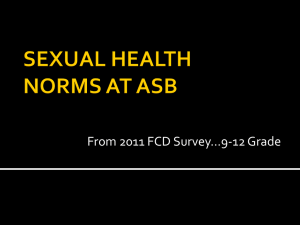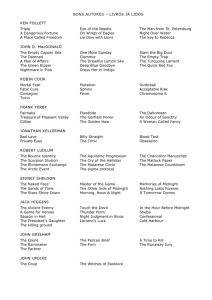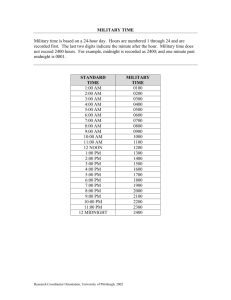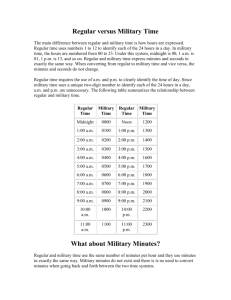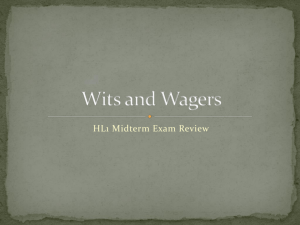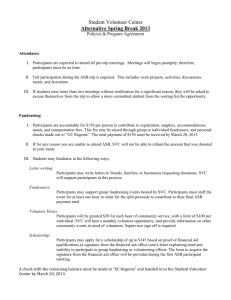PP Presentation - Molloy College
advertisement
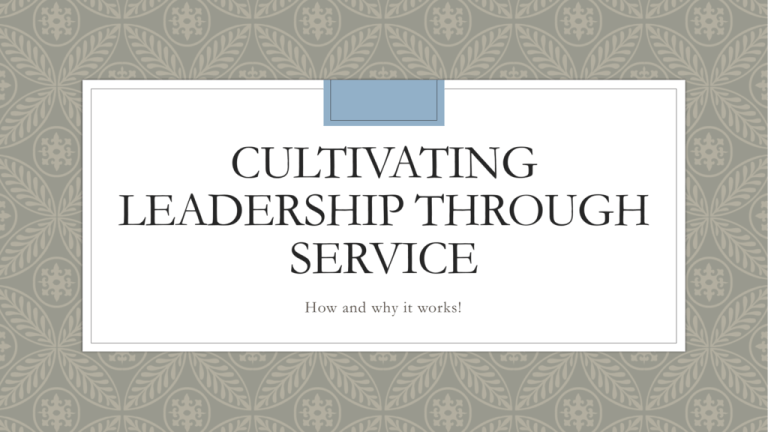
CULTIVATING LEADERSHIP THROUGH SERVICE How and why it works! LEARNING OUTCOMES 1) Understanding the differences between admin-driven and student-led programs 2) Identifying the benefits of student-led initiatives 3) Getting a grasp on how to transition Who’s running the show? Administrator-driven programs Student-driven programs ◦ Your idea ◦ Students bring ideas forth ◦ You plan it ◦ You bring them in and delegate tasks ◦ You promote it ◦ Joint promotion ◦ You recruit (often beg) people to sign up ◦ People come to you ◦ You execute it ◦ Joint execution- you delegate tasks ◦ You review it- 1-dimensional analysis ◦ You review it together, for a 2-dimensional perspective ◦ You move on to the next program, demanding your attention ◦ Continuity is possible! Challenges of each Administrator-driven programs Student-driven programs ◦ You are doing all the work! Your energy will wear thin. ◦ Can be hard to begin- ideas are not always realistic and/or actionable ◦ Promotion is hard ◦ More opinions can lead to disagreement ◦ We don’t always speak the same language (Twitter, etc.). ◦ Fewer ideas ◦ We get disconnected from the their experience as a young adult, at a certain point. ◦ Reliability of team members for follow-thru ◦ Self-doubt as students, working with peers Strengths of each Administrator-driven programs ◦ We have experience and insight; we know what is reasonable and what is not ◦ We have resources and connections ◦ We have institutional knowledge and history ◦ We have status on campus- a platform on which to stand Student-driven programs ◦ We have rapport with students as peers ◦ We think outside the box ◦ We have enthusiasm every time! ◦ We have cultural knowledge ◦ What ideas might be of interest ◦ How to communicate those ideas effectively The ideal balance ◦ It is always best to have student input- it keeps our programs relevant ◦ It is beneficial to the administration to share responsibilities ◦ It is beneficial to students to have responsibilities and be accountable to the institution and partner agencyfor duration of program AND in the long run ◦ It is beneficial to student body to see peers modeling social responsibility- creates culture of service ◦ The best results come from collaborative relationship with student leaders- benefit to program! Getting there o Define responsibilities for students and admins o Give individual attention to student leaders to develop their skills and game plan o Once logistics of project are set, turn over control of group to student leaders, but stay close by for support o Allow all students to take a piece of the pie- everyone contributes Why service? Leadership skills can be developed in a multitude of applications- academics, student activities, fine arts- it is just a matter of taking on responsibility. Service awakens that which makes us most human- compassion. When we reach students in the service of others, we are nurturing something that cannot be taught- rather, it is caught. ◦ Community service is relevant to every major and every profession ◦ Effective service comes from engaged volunteers ◦ Effective leaders engage in meaningful service ANATOMY OF A STUDENT LEADER What are we looking for? ◦ Ethical decision-making ◦ Reliability and accountability ◦ Availability ◦ Communication skills ◦ Internal motivation to succeed ◦ Interest in cause ◦ Passion for greater good ◦ Commitment to the college/university How can we develop these qualities in students? ◦ By holding them to a higher standard- people “rise to the occasion” when you “raise the bar” ◦ By paying attention to their skills and learning style- maximize their individual strengths to get the highest return ◦ By design- do not allow people to be invisible! ◦ Utilize a variety of activities to reveal what each person has to contribute to the group ◦ Remember- some of these are inherent traits that aren’t easily taught or learned, but they can be inspired ◦ Internal motivation to succeed ◦ Interest in cause ◦ Passion for greater good ANATOMY OF A SUCCESSFUL STUDENTLED INITIATIVE Ongoing and Episodic Critical components ◦ Team-building opportunities ◦ New experiences ◦ Background knowledge on partner agency ◦ Background knowledge on location, demographics, politics, and culture ◦ Challenges to overcome as a group ◦ Community exposure ◦ Sense of purpose and efficacy ◦ Fun! Ongoing Programs Alternative Spring Break ◦ Ongoing immersion program- 1 week (during Spring Break) ◦ Partner with Habitat for Humanity in different locations ◦ Student group is selected through application process ◦ Weekly meetings from November- March ◦ Teambuilding activities, icebreakers, fundraisers ◦ Optional class Episodic Programs Midnight Run ◦ Episodic, series program ◦ Partners with Midnight Run Organization ◦ Organized through Rotaract Club ◦ Club meets weekly, event takes place monthly ◦ Clothing drives supply program ◦ Students self-select into club and for each individual event HOW ARE WE ADDRESSING THE CRITICAL COMPONENTS FOR SUCCESS? Teambuilding Ongoing- ASB ◦ ◦ ◦ ◦ ◦ ◦ ◦ Weekly meetings with group Ice breakers at every meeting Journal buddies Fundraising Meal prep Reflections Group activities Episodic- Midnight Run ◦ Weekly meetings for Rotaract ◦ Ice breakers (Happy Quarters) ◦ Fundraising ◦ Collecting supplies ◦ Meal prep ◦ Group activities Opportunity for student leadership- put student leaders in charge of icebreakers and group activities; teambuilding brings everyone to the table! New Experiences Ongoing- ASB ◦ Visiting new places ◦ Changing up the sites ◦ Taking advantage of time spent away from campus ◦ Site-seeing Episodic- Midnight Run ◦ New participants every time ◦ Different stops every time ◦ Different consumers every time ◦ Focus on different supplies every time Opportunity for student leadership- use student input when selecting service sites; when it is new for the admin, too, there is a greater sense of partnership versus leadership Background knowledge of partner agency Ongoing- ASB Episodic- Midnight Run ◦ Information sessions for program ◦ Rotaract Club advocates ◦ HFH Campus Chapter ◦ Club fairs ◦ ASB review program ◦ Consumer representatives to Midnight Run Organization are present on Runs ◦ Print materials ◦ Group discussion Opportunity for student leadership- have student leaders help design and present materials Background knowledge of location, demographics, culture, politics Ongoing- ASB Episodic- Midnight Run ◦ Students responsible for group discussion during team meetings ◦ Students responsible for group discussion during club meetings ◦ Conducting research prior to meetings ◦ Coursework (where applicable) ◦ Visiting sites of historical, cultural, or political significance ◦ Discussion with consumers on Runs ◦ *local culture ◦ Discussion with locals and consumers on trip Opportunity for student leadership- have students do independent research, and student leaders facilitate discussion Challenges to overcome as a group Ongoing- ASB Episodic- Midnight Run ◦ Fundraising ◦ Fundraising ◦ Travel ◦ Collecting supplies ◦ Meal preparation ◦ Meals preparation ◦ Restricted technology ◦ Student participation ◦ $5 dinner ◦ Reflection activities ◦ Construction Opportunity for student leadership- make students responsible for their own fundraising; divide up various preparatory tasks into teams; make students responsible for designing reflections! Community exposure Ongoing- ASB ◦ Interaction with HFH affiliate Episodic- Midnight Run ◦ Interaction with homeless population on Run ◦ Interaction with homeowners ◦ Interaction with host church and congregation Opportunity for student leadership- students are in direct service, so they must interact with others; discuss questions beforehand, so students are prepared to talk to different people Sense of purpose and efficacy Ongoing- ASB ◦ Discussion during group meetings Episodic- Midnight Run ◦ Of community needs ◦ Discussion during club meetings, pre and post Run ◦ Of HFH mission ◦ Direct service ◦ Of Dominican mission ◦ Instant gratification ◦ Of their own power ◦ Reflection activities ◦ Opportunities for continuity ◦ Direct service ◦ Opportunities for continuity Opportunity for student leadership- students are responsible for contributing to prep meetings, reflections, and actual service! Fun! Ongoing- ASB Episodic- Midnight Run ◦ Teambuilding ◦ Teambuilding ◦ Seeing new things ◦ Seeing new things ◦ Meeting new people ◦ Meeting new people ◦ Learning new skills ◦ Restricting technology Opportunity for student leadership- they bring the fun! It is easy to have fun when you feel good about what you are doing and who you are with. Having fun with others builds self-esteem, which begins the process over! WRAPPING UP Final thoughts ◦ Young adults are often looking for a sense of belonging. Volunteering with a group builds a sense of community, which everyone belongs to. ◦ Doing good, fulfilling work makes people feel better about themselves and what they can contribute to our world. These are the people that we look up to! ◦ We are nurturing compassion which can be applied to any discipline for the improvement of society; we are just getting them warmed up! ◦ Quote from 2014 graduate: “…I knew from then on I had to always volunteer, because it was nourishment to my soul. Outreach means lending a hand to lift up. When we volunteer, we are a symbol of God’s love, and that should not be taken lightly…I believe I became a more compassionate person due to volunteering, and I have a strong sense of self due to being an RA…” ~ Vaughna Jarvis QUESTIONS?
